Analysis of Project Management Practices in Poly Product Industries
VerifiedAdded on 2020/04/15
|8
|1594
|37
AI Summary
The provided content delves into various aspects of project management and quality assurance utilized by Poly Product Industries. It discusses techniques such as Building Information Modelling (BIM) for enhanced project benefits, work breakdown structures for detailed deliverable measurement, and quality checklists to maintain standards. The report outlines the importance of planning tools like scope statements that ensure technical performance adherence and procurement processes aligned with project specifications. Quality assurance in this context involves the use of metrics for production schedules and cost controls, while quality control focuses on monitoring outcomes against requirements through work performance data analysis. References from established authors such as Larson and PMI are cited to support methodologies and frameworks presented.
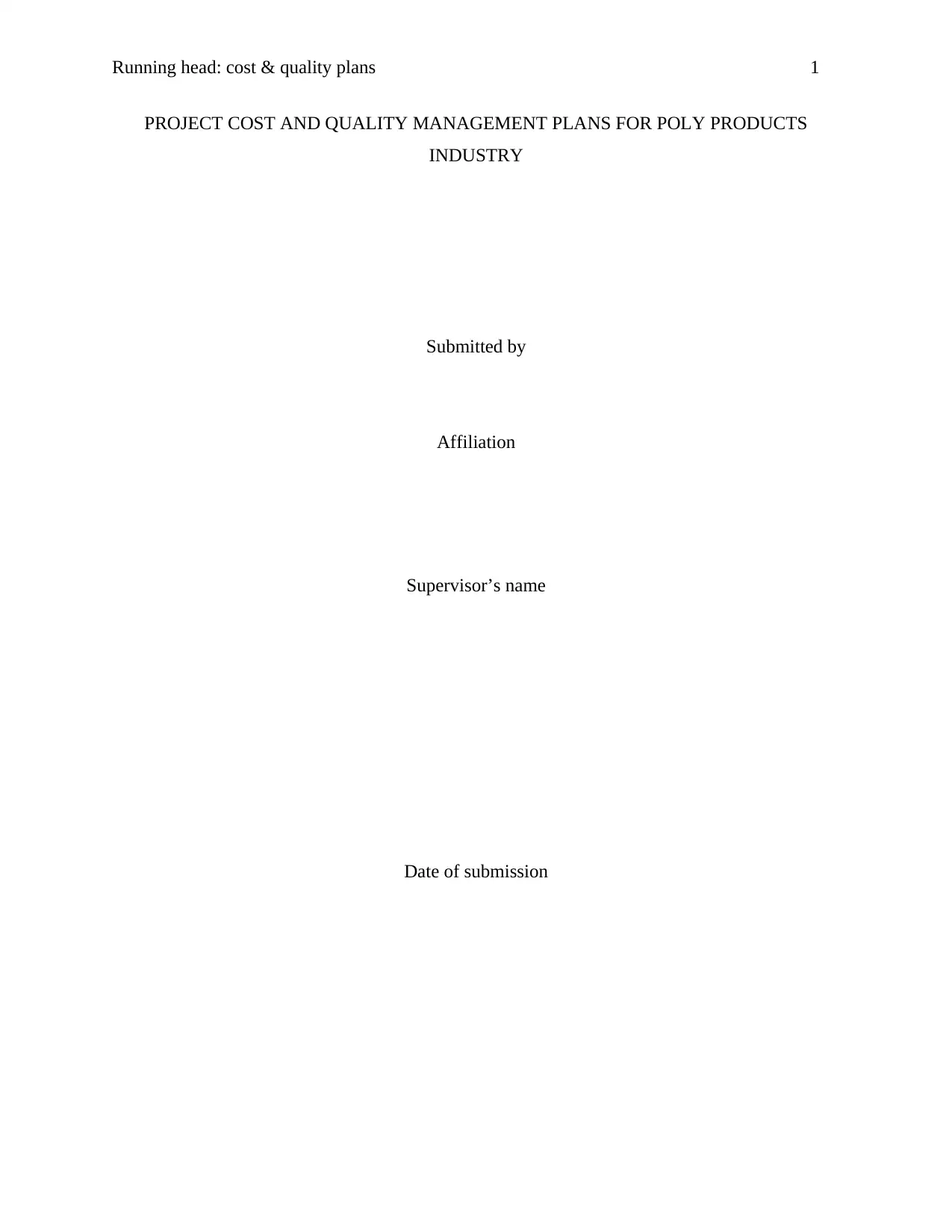
Running head: cost & quality plans 1
PROJECT COST AND QUALITY MANAGEMENT PLANS FOR POLY PRODUCTS
INDUSTRY
Submitted by
Affiliation
Supervisor’s name
Date of submission
PROJECT COST AND QUALITY MANAGEMENT PLANS FOR POLY PRODUCTS
INDUSTRY
Submitted by
Affiliation
Supervisor’s name
Date of submission
Paraphrase This Document
Need a fresh take? Get an instant paraphrase of this document with our AI Paraphraser
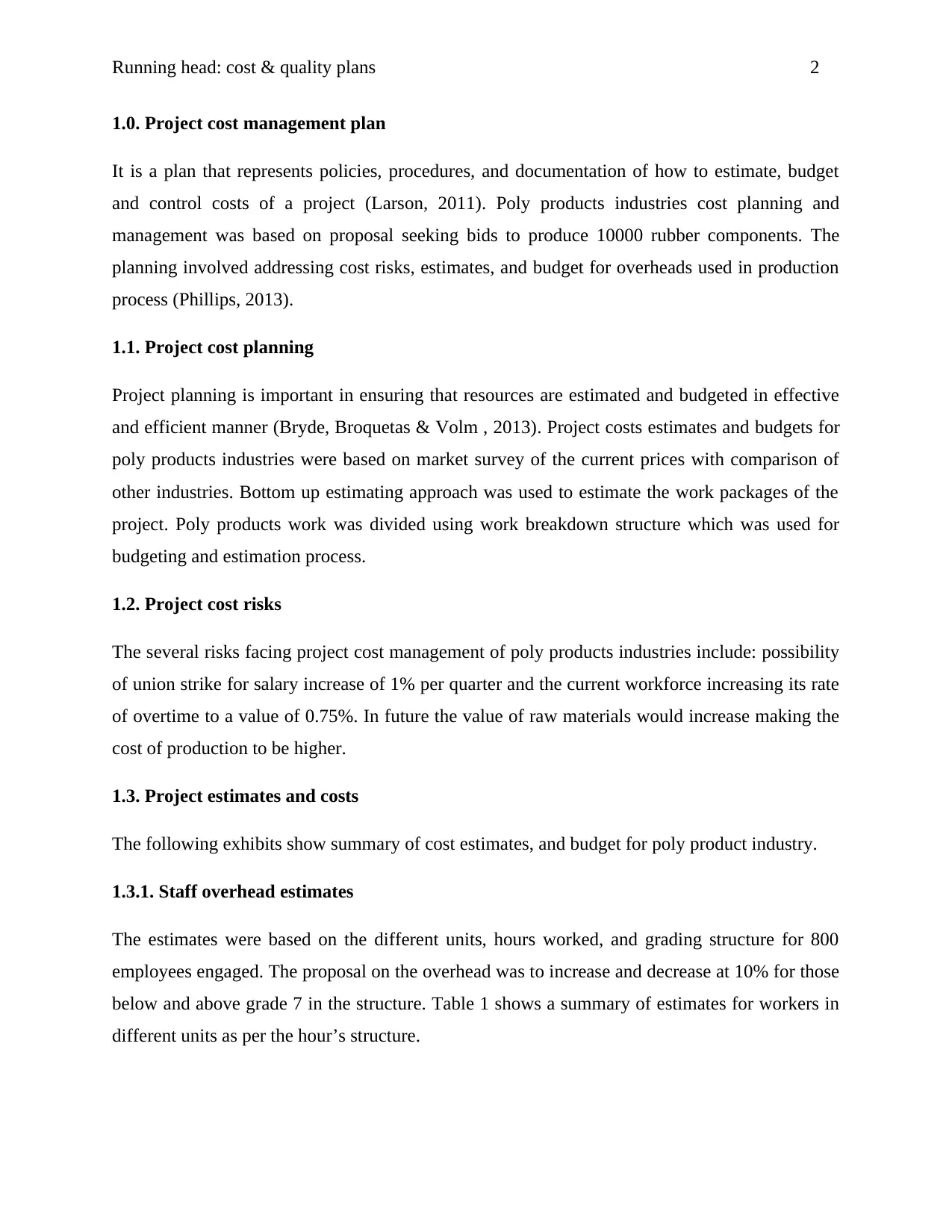
Running head: cost & quality plans 2
1.0. Project cost management plan
It is a plan that represents policies, procedures, and documentation of how to estimate, budget
and control costs of a project (Larson, 2011). Poly products industries cost planning and
management was based on proposal seeking bids to produce 10000 rubber components. The
planning involved addressing cost risks, estimates, and budget for overheads used in production
process (Phillips, 2013).
1.1. Project cost planning
Project planning is important in ensuring that resources are estimated and budgeted in effective
and efficient manner (Bryde, Broquetas & Volm , 2013). Project costs estimates and budgets for
poly products industries were based on market survey of the current prices with comparison of
other industries. Bottom up estimating approach was used to estimate the work packages of the
project. Poly products work was divided using work breakdown structure which was used for
budgeting and estimation process.
1.2. Project cost risks
The several risks facing project cost management of poly products industries include: possibility
of union strike for salary increase of 1% per quarter and the current workforce increasing its rate
of overtime to a value of 0.75%. In future the value of raw materials would increase making the
cost of production to be higher.
1.3. Project estimates and costs
The following exhibits show summary of cost estimates, and budget for poly product industry.
1.3.1. Staff overhead estimates
The estimates were based on the different units, hours worked, and grading structure for 800
employees engaged. The proposal on the overhead was to increase and decrease at 10% for those
below and above grade 7 in the structure. Table 1 shows a summary of estimates for workers in
different units as per the hour’s structure.
1.0. Project cost management plan
It is a plan that represents policies, procedures, and documentation of how to estimate, budget
and control costs of a project (Larson, 2011). Poly products industries cost planning and
management was based on proposal seeking bids to produce 10000 rubber components. The
planning involved addressing cost risks, estimates, and budget for overheads used in production
process (Phillips, 2013).
1.1. Project cost planning
Project planning is important in ensuring that resources are estimated and budgeted in effective
and efficient manner (Bryde, Broquetas & Volm , 2013). Project costs estimates and budgets for
poly products industries were based on market survey of the current prices with comparison of
other industries. Bottom up estimating approach was used to estimate the work packages of the
project. Poly products work was divided using work breakdown structure which was used for
budgeting and estimation process.
1.2. Project cost risks
The several risks facing project cost management of poly products industries include: possibility
of union strike for salary increase of 1% per quarter and the current workforce increasing its rate
of overtime to a value of 0.75%. In future the value of raw materials would increase making the
cost of production to be higher.
1.3. Project estimates and costs
The following exhibits show summary of cost estimates, and budget for poly product industry.
1.3.1. Staff overhead estimates
The estimates were based on the different units, hours worked, and grading structure for 800
employees engaged. The proposal on the overhead was to increase and decrease at 10% for those
below and above grade 7 in the structure. Table 1 shows a summary of estimates for workers in
different units as per the hour’s structure.
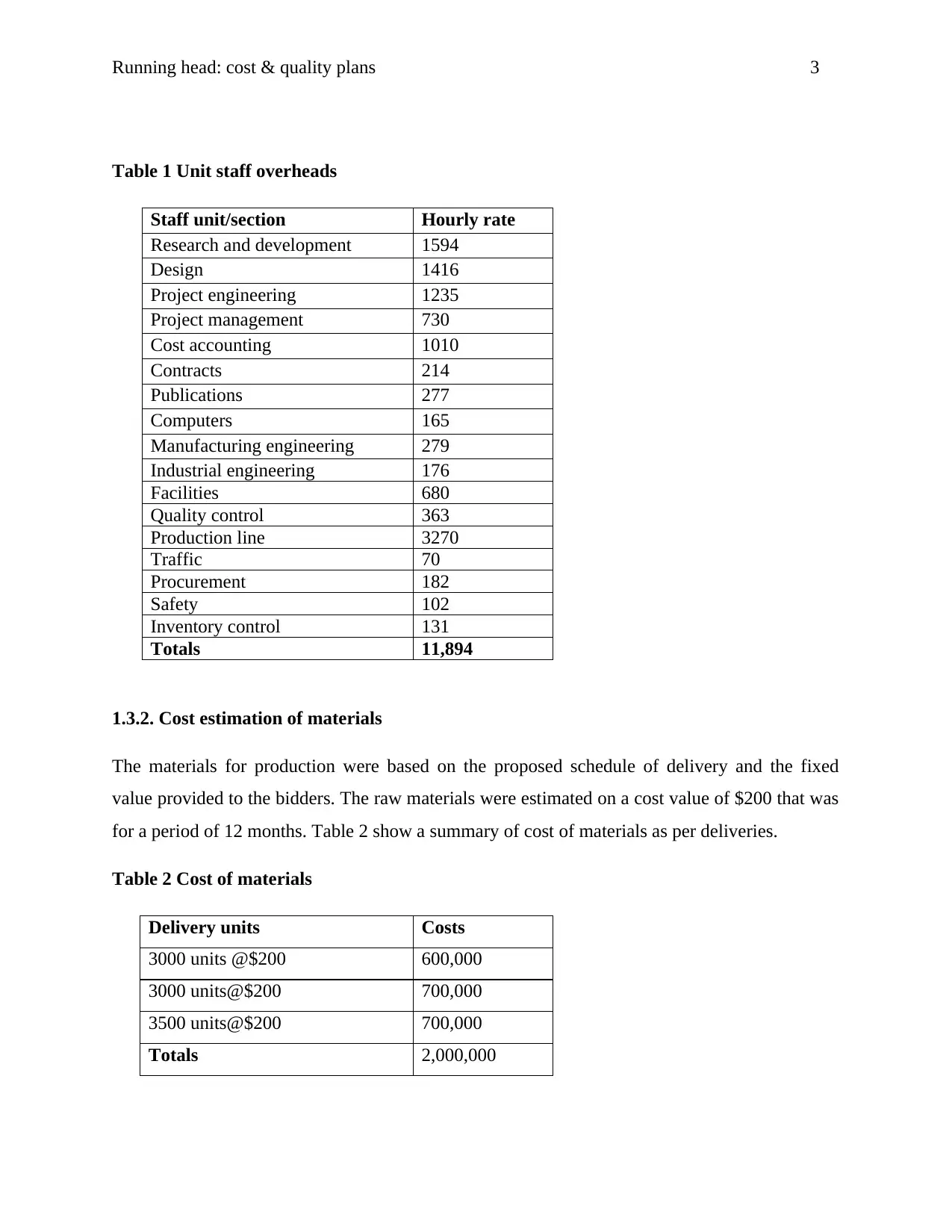
Running head: cost & quality plans 3
Table 1 Unit staff overheads
Staff unit/section Hourly rate
Research and development 1594
Design 1416
Project engineering 1235
Project management 730
Cost accounting 1010
Contracts 214
Publications 277
Computers 165
Manufacturing engineering 279
Industrial engineering 176
Facilities 680
Quality control 363
Production line 3270
Traffic 70
Procurement 182
Safety 102
Inventory control 131
Totals 11,894
1.3.2. Cost estimation of materials
The materials for production were based on the proposed schedule of delivery and the fixed
value provided to the bidders. The raw materials were estimated on a cost value of $200 that was
for a period of 12 months. Table 2 show a summary of cost of materials as per deliveries.
Table 2 Cost of materials
Delivery units Costs
3000 units @$200 600,000
3000 units@$200 700,000
3500 units@$200 700,000
Totals 2,000,000
Table 1 Unit staff overheads
Staff unit/section Hourly rate
Research and development 1594
Design 1416
Project engineering 1235
Project management 730
Cost accounting 1010
Contracts 214
Publications 277
Computers 165
Manufacturing engineering 279
Industrial engineering 176
Facilities 680
Quality control 363
Production line 3270
Traffic 70
Procurement 182
Safety 102
Inventory control 131
Totals 11,894
1.3.2. Cost estimation of materials
The materials for production were based on the proposed schedule of delivery and the fixed
value provided to the bidders. The raw materials were estimated on a cost value of $200 that was
for a period of 12 months. Table 2 show a summary of cost of materials as per deliveries.
Table 2 Cost of materials
Delivery units Costs
3000 units @$200 600,000
3000 units@$200 700,000
3500 units@$200 700,000
Totals 2,000,000
⊘ This is a preview!⊘
Do you want full access?
Subscribe today to unlock all pages.

Trusted by 1+ million students worldwide
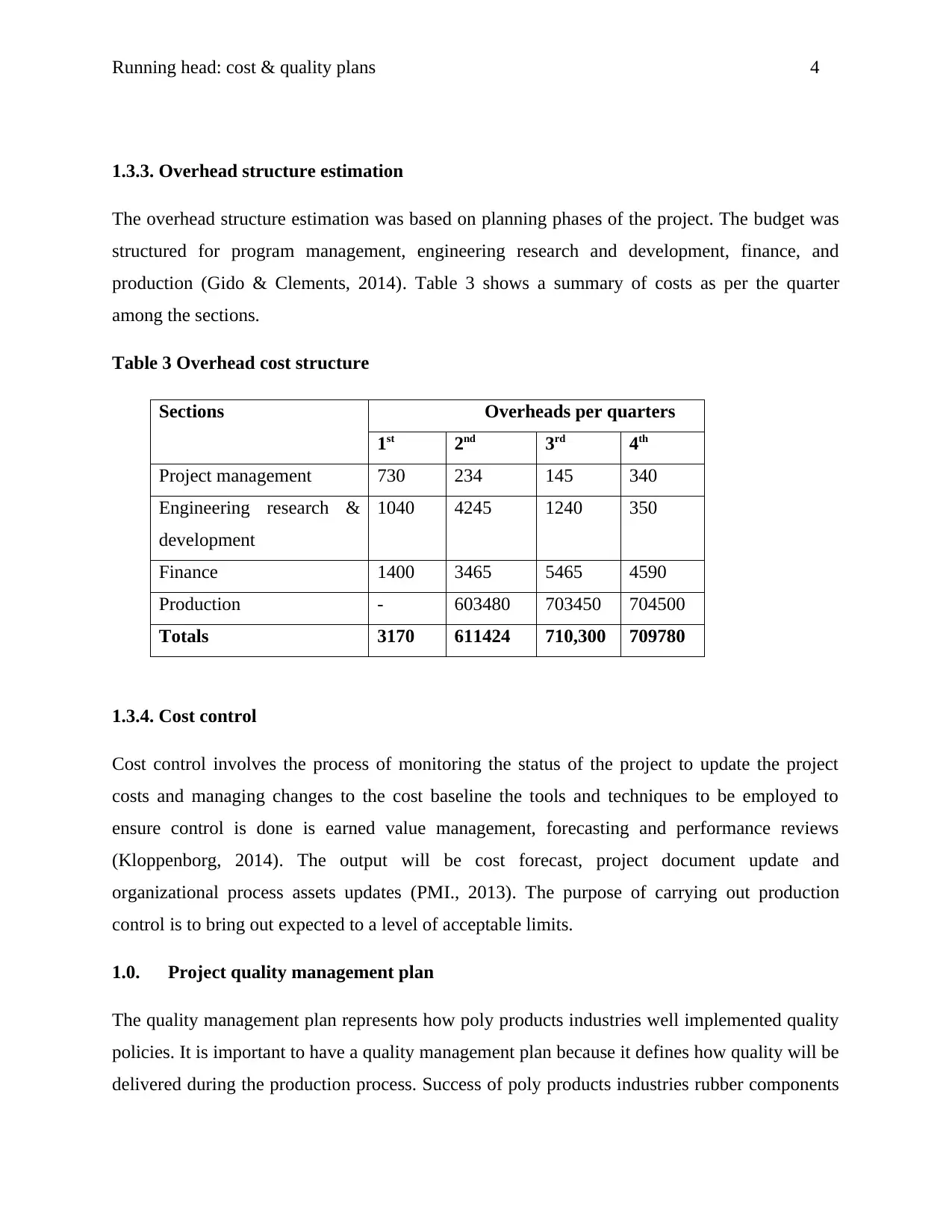
Running head: cost & quality plans 4
1.3.3. Overhead structure estimation
The overhead structure estimation was based on planning phases of the project. The budget was
structured for program management, engineering research and development, finance, and
production (Gido & Clements, 2014). Table 3 shows a summary of costs as per the quarter
among the sections.
Table 3 Overhead cost structure
Sections Overheads per quarters
1st 2nd 3rd 4th
Project management 730 234 145 340
Engineering research &
development
1040 4245 1240 350
Finance 1400 3465 5465 4590
Production - 603480 703450 704500
Totals 3170 611424 710,300 709780
1.3.4. Cost control
Cost control involves the process of monitoring the status of the project to update the project
costs and managing changes to the cost baseline the tools and techniques to be employed to
ensure control is done is earned value management, forecasting and performance reviews
(Kloppenborg, 2014). The output will be cost forecast, project document update and
organizational process assets updates (PMI., 2013). The purpose of carrying out production
control is to bring out expected to a level of acceptable limits.
1.0. Project quality management plan
The quality management plan represents how poly products industries well implemented quality
policies. It is important to have a quality management plan because it defines how quality will be
delivered during the production process. Success of poly products industries rubber components
1.3.3. Overhead structure estimation
The overhead structure estimation was based on planning phases of the project. The budget was
structured for program management, engineering research and development, finance, and
production (Gido & Clements, 2014). Table 3 shows a summary of costs as per the quarter
among the sections.
Table 3 Overhead cost structure
Sections Overheads per quarters
1st 2nd 3rd 4th
Project management 730 234 145 340
Engineering research &
development
1040 4245 1240 350
Finance 1400 3465 5465 4590
Production - 603480 703450 704500
Totals 3170 611424 710,300 709780
1.3.4. Cost control
Cost control involves the process of monitoring the status of the project to update the project
costs and managing changes to the cost baseline the tools and techniques to be employed to
ensure control is done is earned value management, forecasting and performance reviews
(Kloppenborg, 2014). The output will be cost forecast, project document update and
organizational process assets updates (PMI., 2013). The purpose of carrying out production
control is to bring out expected to a level of acceptable limits.
1.0. Project quality management plan
The quality management plan represents how poly products industries well implemented quality
policies. It is important to have a quality management plan because it defines how quality will be
delivered during the production process. Success of poly products industries rubber components
Paraphrase This Document
Need a fresh take? Get an instant paraphrase of this document with our AI Paraphraser
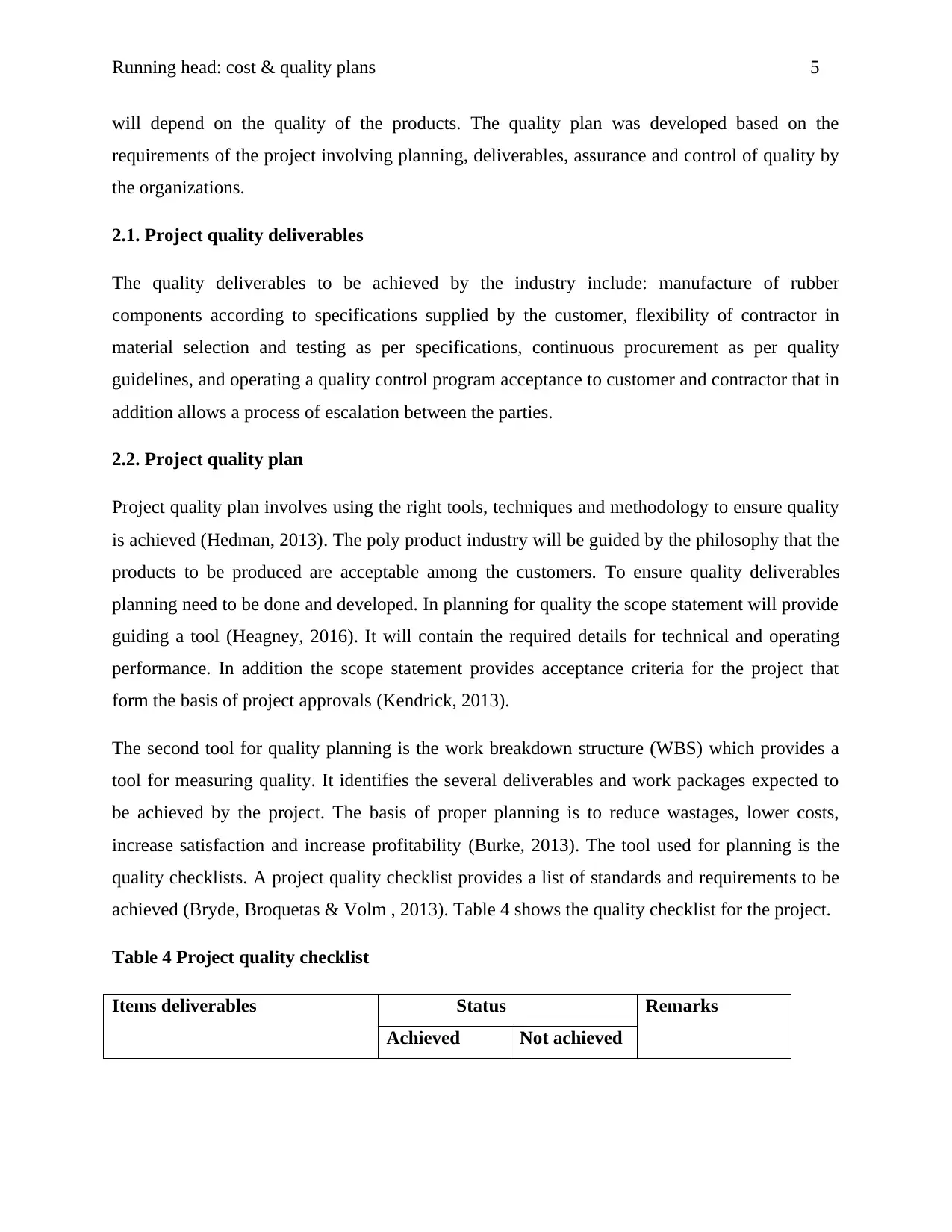
Running head: cost & quality plans 5
will depend on the quality of the products. The quality plan was developed based on the
requirements of the project involving planning, deliverables, assurance and control of quality by
the organizations.
2.1. Project quality deliverables
The quality deliverables to be achieved by the industry include: manufacture of rubber
components according to specifications supplied by the customer, flexibility of contractor in
material selection and testing as per specifications, continuous procurement as per quality
guidelines, and operating a quality control program acceptance to customer and contractor that in
addition allows a process of escalation between the parties.
2.2. Project quality plan
Project quality plan involves using the right tools, techniques and methodology to ensure quality
is achieved (Hedman, 2013). The poly product industry will be guided by the philosophy that the
products to be produced are acceptable among the customers. To ensure quality deliverables
planning need to be done and developed. In planning for quality the scope statement will provide
guiding a tool (Heagney, 2016). It will contain the required details for technical and operating
performance. In addition the scope statement provides acceptance criteria for the project that
form the basis of project approvals (Kendrick, 2013).
The second tool for quality planning is the work breakdown structure (WBS) which provides a
tool for measuring quality. It identifies the several deliverables and work packages expected to
be achieved by the project. The basis of proper planning is to reduce wastages, lower costs,
increase satisfaction and increase profitability (Burke, 2013). The tool used for planning is the
quality checklists. A project quality checklist provides a list of standards and requirements to be
achieved (Bryde, Broquetas & Volm , 2013). Table 4 shows the quality checklist for the project.
Table 4 Project quality checklist
Items deliverables Status Remarks
Achieved Not achieved
will depend on the quality of the products. The quality plan was developed based on the
requirements of the project involving planning, deliverables, assurance and control of quality by
the organizations.
2.1. Project quality deliverables
The quality deliverables to be achieved by the industry include: manufacture of rubber
components according to specifications supplied by the customer, flexibility of contractor in
material selection and testing as per specifications, continuous procurement as per quality
guidelines, and operating a quality control program acceptance to customer and contractor that in
addition allows a process of escalation between the parties.
2.2. Project quality plan
Project quality plan involves using the right tools, techniques and methodology to ensure quality
is achieved (Hedman, 2013). The poly product industry will be guided by the philosophy that the
products to be produced are acceptable among the customers. To ensure quality deliverables
planning need to be done and developed. In planning for quality the scope statement will provide
guiding a tool (Heagney, 2016). It will contain the required details for technical and operating
performance. In addition the scope statement provides acceptance criteria for the project that
form the basis of project approvals (Kendrick, 2013).
The second tool for quality planning is the work breakdown structure (WBS) which provides a
tool for measuring quality. It identifies the several deliverables and work packages expected to
be achieved by the project. The basis of proper planning is to reduce wastages, lower costs,
increase satisfaction and increase profitability (Burke, 2013). The tool used for planning is the
quality checklists. A project quality checklist provides a list of standards and requirements to be
achieved (Bryde, Broquetas & Volm , 2013). Table 4 shows the quality checklist for the project.
Table 4 Project quality checklist
Items deliverables Status Remarks
Achieved Not achieved
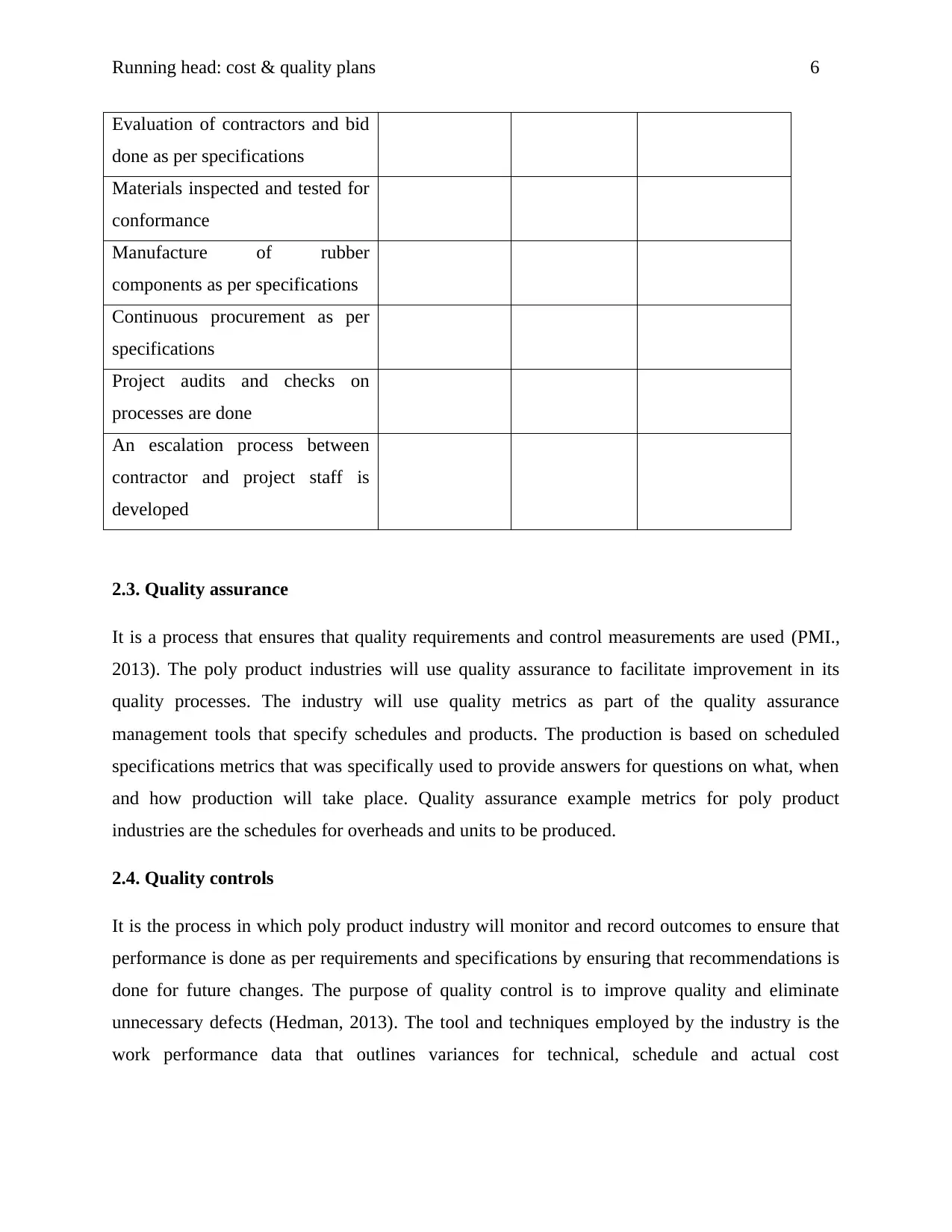
Running head: cost & quality plans 6
Evaluation of contractors and bid
done as per specifications
Materials inspected and tested for
conformance
Manufacture of rubber
components as per specifications
Continuous procurement as per
specifications
Project audits and checks on
processes are done
An escalation process between
contractor and project staff is
developed
2.3. Quality assurance
It is a process that ensures that quality requirements and control measurements are used (PMI.,
2013). The poly product industries will use quality assurance to facilitate improvement in its
quality processes. The industry will use quality metrics as part of the quality assurance
management tools that specify schedules and products. The production is based on scheduled
specifications metrics that was specifically used to provide answers for questions on what, when
and how production will take place. Quality assurance example metrics for poly product
industries are the schedules for overheads and units to be produced.
2.4. Quality controls
It is the process in which poly product industry will monitor and record outcomes to ensure that
performance is done as per requirements and specifications by ensuring that recommendations is
done for future changes. The purpose of quality control is to improve quality and eliminate
unnecessary defects (Hedman, 2013). The tool and techniques employed by the industry is the
work performance data that outlines variances for technical, schedule and actual cost
Evaluation of contractors and bid
done as per specifications
Materials inspected and tested for
conformance
Manufacture of rubber
components as per specifications
Continuous procurement as per
specifications
Project audits and checks on
processes are done
An escalation process between
contractor and project staff is
developed
2.3. Quality assurance
It is a process that ensures that quality requirements and control measurements are used (PMI.,
2013). The poly product industries will use quality assurance to facilitate improvement in its
quality processes. The industry will use quality metrics as part of the quality assurance
management tools that specify schedules and products. The production is based on scheduled
specifications metrics that was specifically used to provide answers for questions on what, when
and how production will take place. Quality assurance example metrics for poly product
industries are the schedules for overheads and units to be produced.
2.4. Quality controls
It is the process in which poly product industry will monitor and record outcomes to ensure that
performance is done as per requirements and specifications by ensuring that recommendations is
done for future changes. The purpose of quality control is to improve quality and eliminate
unnecessary defects (Hedman, 2013). The tool and techniques employed by the industry is the
work performance data that outlines variances for technical, schedule and actual cost
⊘ This is a preview!⊘
Do you want full access?
Subscribe today to unlock all pages.

Trusted by 1+ million students worldwide
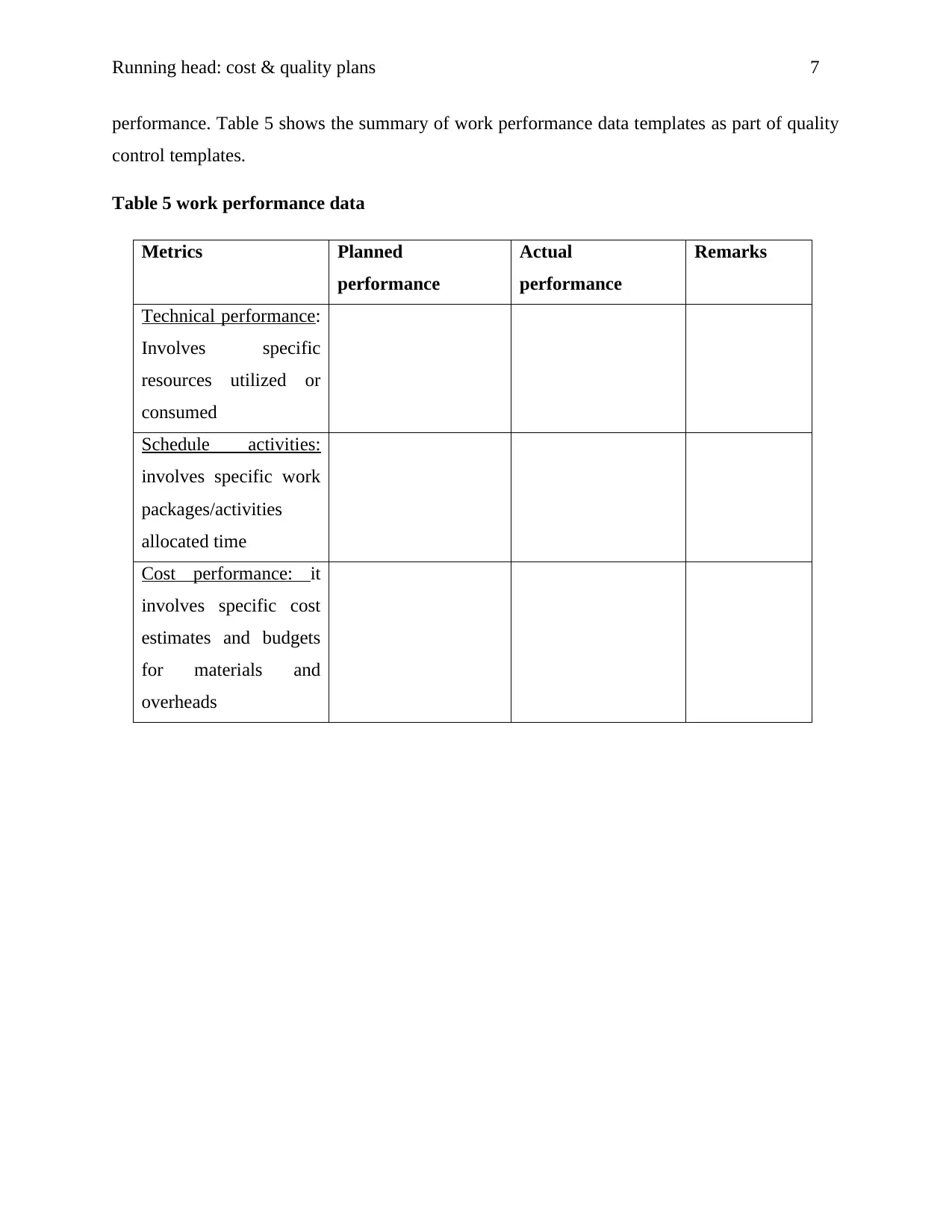
Running head: cost & quality plans 7
performance. Table 5 shows the summary of work performance data templates as part of quality
control templates.
Table 5 work performance data
Metrics Planned
performance
Actual
performance
Remarks
Technical performance:
Involves specific
resources utilized or
consumed
Schedule activities:
involves specific work
packages/activities
allocated time
Cost performance: it
involves specific cost
estimates and budgets
for materials and
overheads
performance. Table 5 shows the summary of work performance data templates as part of quality
control templates.
Table 5 work performance data
Metrics Planned
performance
Actual
performance
Remarks
Technical performance:
Involves specific
resources utilized or
consumed
Schedule activities:
involves specific work
packages/activities
allocated time
Cost performance: it
involves specific cost
estimates and budgets
for materials and
overheads
Paraphrase This Document
Need a fresh take? Get an instant paraphrase of this document with our AI Paraphraser
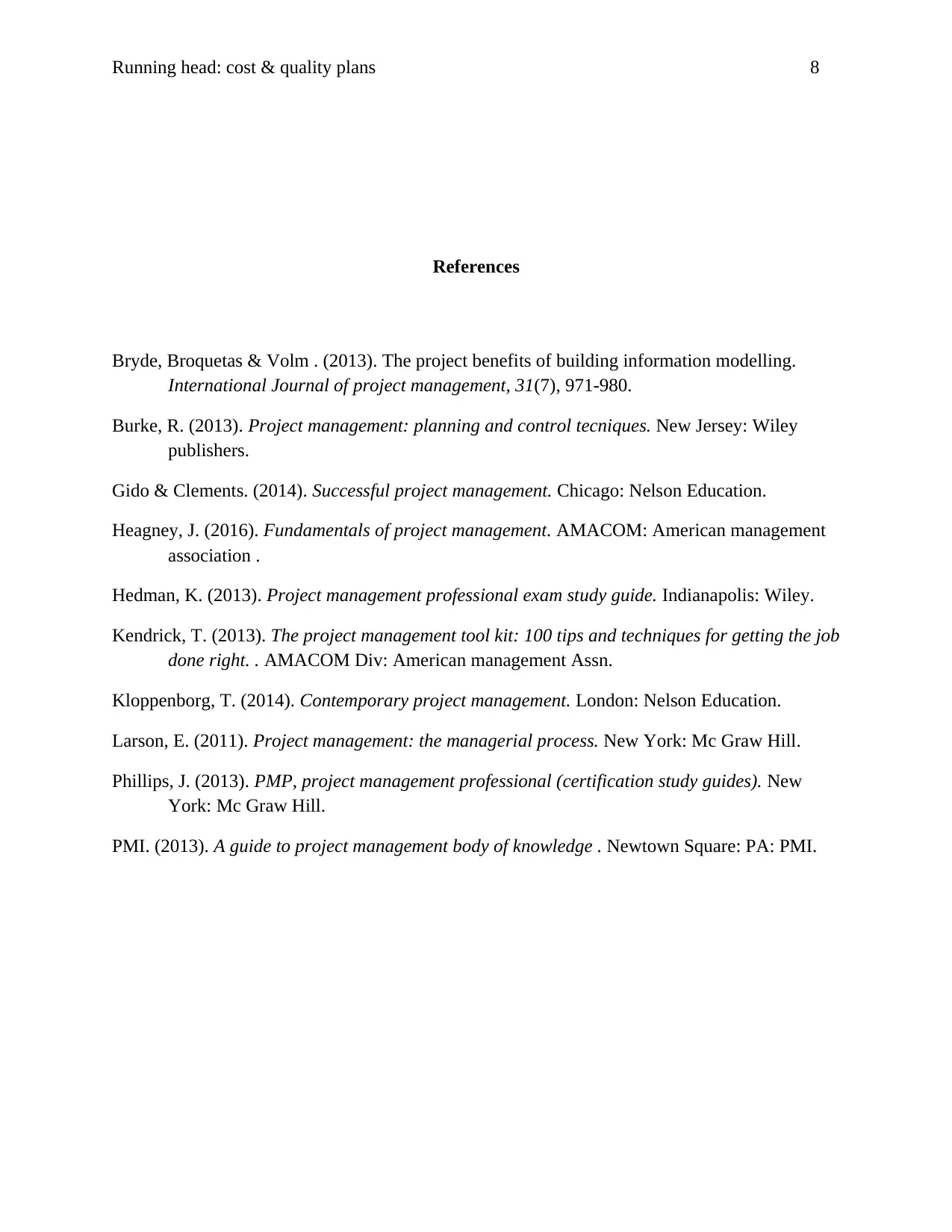
Running head: cost & quality plans 8
References
Bryde, Broquetas & Volm . (2013). The project benefits of building information modelling.
International Journal of project management, 31(7), 971-980.
Burke, R. (2013). Project management: planning and control tecniques. New Jersey: Wiley
publishers.
Gido & Clements. (2014). Successful project management. Chicago: Nelson Education.
Heagney, J. (2016). Fundamentals of project management. AMACOM: American management
association .
Hedman, K. (2013). Project management professional exam study guide. Indianapolis: Wiley.
Kendrick, T. (2013). The project management tool kit: 100 tips and techniques for getting the job
done right. . AMACOM Div: American management Assn.
Kloppenborg, T. (2014). Contemporary project management. London: Nelson Education.
Larson, E. (2011). Project management: the managerial process. New York: Mc Graw Hill.
Phillips, J. (2013). PMP, project management professional (certification study guides). New
York: Mc Graw Hill.
PMI. (2013). A guide to project management body of knowledge . Newtown Square: PA: PMI.
References
Bryde, Broquetas & Volm . (2013). The project benefits of building information modelling.
International Journal of project management, 31(7), 971-980.
Burke, R. (2013). Project management: planning and control tecniques. New Jersey: Wiley
publishers.
Gido & Clements. (2014). Successful project management. Chicago: Nelson Education.
Heagney, J. (2016). Fundamentals of project management. AMACOM: American management
association .
Hedman, K. (2013). Project management professional exam study guide. Indianapolis: Wiley.
Kendrick, T. (2013). The project management tool kit: 100 tips and techniques for getting the job
done right. . AMACOM Div: American management Assn.
Kloppenborg, T. (2014). Contemporary project management. London: Nelson Education.
Larson, E. (2011). Project management: the managerial process. New York: Mc Graw Hill.
Phillips, J. (2013). PMP, project management professional (certification study guides). New
York: Mc Graw Hill.
PMI. (2013). A guide to project management body of knowledge . Newtown Square: PA: PMI.
1 out of 8
Related Documents
Your All-in-One AI-Powered Toolkit for Academic Success.
+13062052269
info@desklib.com
Available 24*7 on WhatsApp / Email
![[object Object]](/_next/static/media/star-bottom.7253800d.svg)
Unlock your academic potential
Copyright © 2020–2025 A2Z Services. All Rights Reserved. Developed and managed by ZUCOL.




